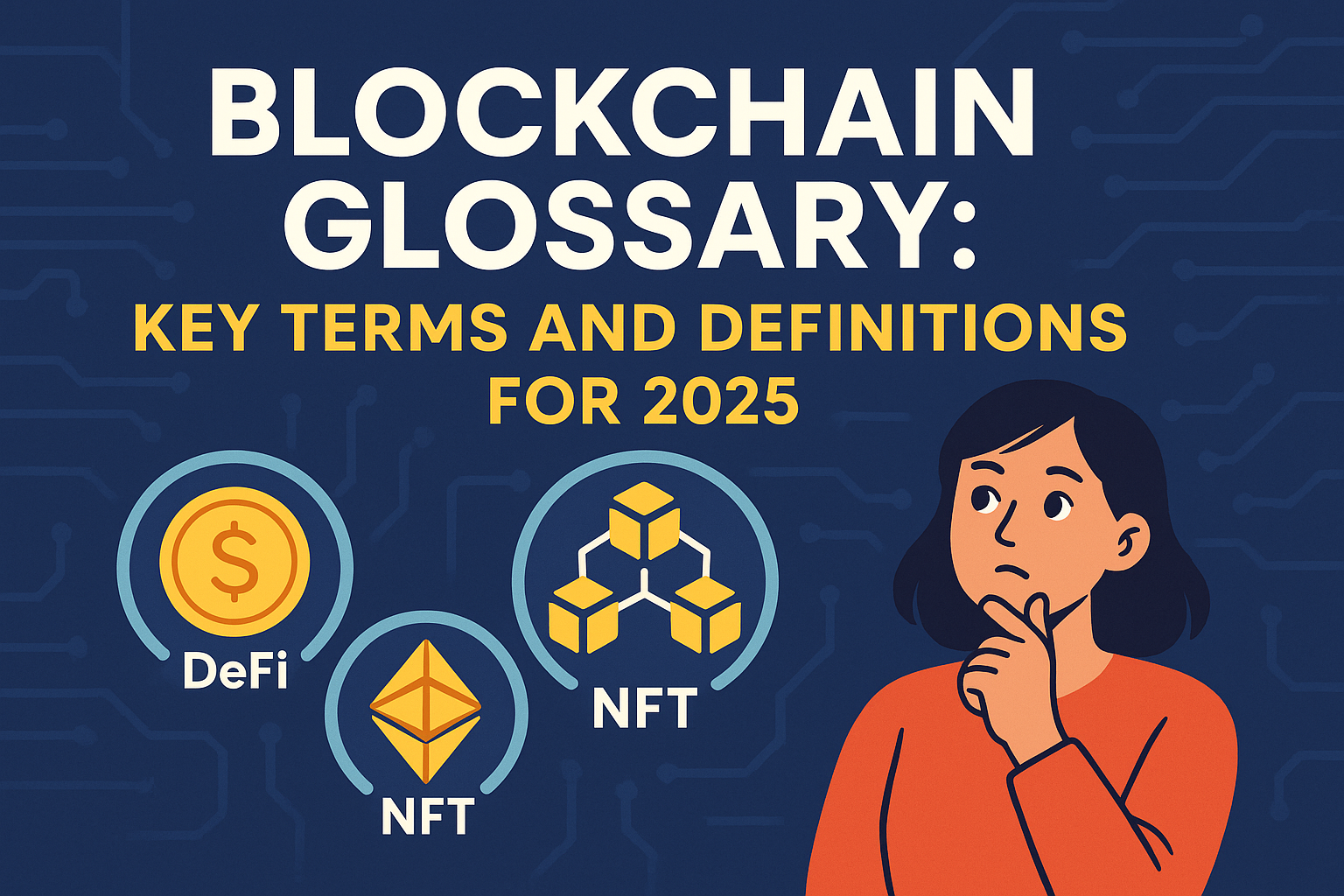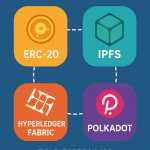Ever felt overwhelmed by blockchain jargon like “smart contracts” or “DeFi” while exploring this tech? You’re not alone—blockchain terminology can seem like a foreign language! In 2025, understanding these terms is key to navigating the blockchain world, whether you’re a beginner or a seasoned enthusiast. This blockchain glossary breaks down essential blockchain terms 2025, offering clear definitions, real-world examples, and trends to make the tech accessible. Let’s demystify blockchain together!

1. Blockchain Basics: Core Terms
Let’s start with the foundational terms that define blockchain technology. In 2025, understanding these basics is crucial for grasping how blockchains operate.
Key Terms:
- Blockchain: A decentralized ledger recording transactions across a network of computers. Each “block” contains data, linked in a “chain.” Bitcoin, for example, has processed 800 million transactions since 2009, per Blockchain.com 2025 data.
- Node: A computer in the blockchain network that validates transactions. Ethereum has over 10,000 nodes in 2025, per Etherscan.
- Wallet: A software or device storing private and public keys for transactions. I set up a MetaMask wallet last year—it made managing crypto so easy!
Real-World Insight: When I first bought Bitcoin, I was confused by “nodes”—but learning they’re just computers ensuring security made it click. For more basics, check our Blockchain 101 guide.
2. Consensus Mechanisms: How Blockchains Agree
Consensus mechanisms are protocols ensuring all nodes agree on the blockchain’s state. They’re critical for security and decentralization.
| Mechanism | Definition | Example | Energy Use (2025) |
|---|---|---|---|
| Proof of Work (PoW) | Miners solve puzzles to validate transactions. | Bitcoin | 150 TWh/year |
| Proof of Stake (PoS) | Validators stake crypto to confirm transactions. | Ethereum | 2.6 GWh/year |
Trends: In 2025, 70% of new blockchains use PoS, per Chainalysis, due to its energy efficiency. I tried staking ETH last year—it felt eco-friendly compared to mining! Learn more about these mechanisms in our Proof of Work vs Proof of Stake guide.
3. Smart Contracts and dApps: Automation in Action
These terms power blockchain’s automation capabilities, transforming industries in 2025.
Definitions:
- Smart Contract: Self-executing agreements on the blockchain. Ethereum hosts over 4 million smart contracts, per Etherscan 2025.
- dApp (Decentralized App): Applications running on blockchain networks. Uniswap, a dApp, processed $1 billion daily in trades in 2025, per Uniswap’s report.
Use Case: I used a smart contract on Uniswap to swap tokens—it executed instantly without a middleman. It felt like magic! Smart contracts are key to many 2025 blockchain use cases.
4. DeFi and NFTs: Financial and Digital Ownership
These terms define blockchain’s role in finance and digital assets, booming in 2025.
Key Terms:
- DeFi (Decentralized Finance): Financial services without intermediaries. DeFi manages $400 billion in total value locked (TVL), per DeFi Pulse 2025.
- NFT (Non-Fungible Token): Unique digital assets on the blockchain. Over 50 million NFTs were minted in 2025, per NonFungible.com.
Real-World Example: I bought an NFT artwork last year on OpenSea—it was a unique piece I now own digitally. DeFi and NFTs are reshaping finance and ownership. Explore DeFi in our blockchain in finance guide.
5. Scalability and Interoperability: Advanced Concepts
These terms address blockchain’s growth challenges, crucial for 2025 adoption.
| Term | Definition | Example | Impact (2025) |
|---|---|---|---|
| Scalability | Ability to handle more transactions. | Ethereum (sharding) | 100,000 TPS |
| Interoperability | Blockchains communicating together. | Polkadot | 1,200 dApps |
Trend: In 2025, 50% of dApps use interoperability protocols, per DappRadar. I tried a cross-chain swap last year—it was seamless thanks to Polkadot!
6. Security and Privacy: Protecting the Network
Security and privacy terms are vital for understanding blockchain’s safety in 2025.
Key Terms:
- Private Key: A secret code for accessing your crypto. Losing it means losing access—30% of crypto losses in 2025 were due to lost keys, per Chainalysis.
- Zero-Knowledge Proof (ZKP): Proving a statement without revealing details. Zcash uses ZKP, processing 500,000 private transactions in 2025, per Zcash stats.
Personal Insight: I used Zcash for a private transaction last year—it felt reassuring knowing my data was hidden. Security is a big part of blockchain’s appeal.
7. Trends in Blockchain Terminology for 2025
In 2025, blockchain terminology is evolving with new concepts. Terms like “Layer 2” (e.g., Arbitrum) are trending, with 50% of Ethereum transactions on Layer 2, per Etherscan. “Web3” is also gaining traction, with 70% of developers building Web3 apps, per Stack Overflow 2025.
Emerging Terms:
- Layer 2: Off-chain scaling solutions.
- Web3: A decentralized internet vision.
- Metaverse: Blockchain-powered virtual worlds.
Call to Action: This blockchain glossary is your gateway to understanding the tech—share it with a friend or bookmark it for your blockchain journey! Dive deeper with our Web3 Learning Hub.
Frequently Asked Questions
What is a blockchain in simple terms?
It’s a decentralized ledger recording transactions across many computers, ensuring security and transparency.
What’s the difference between PoW and PoS?
PoW uses mining to validate transactions, while PoS uses staking—PoS is more energy-efficient, using 99.95% less energy.
How do smart contracts work?
They’re self-executing agreements on the blockchain, automating tasks like payments when conditions are met.
What does Web3 mean?
It refers to a decentralized internet powered by blockchain, focusing on user control and ownership.
Related Articles
Ready to Dive Deeper?
We’ve unpacked essential blockchain terms 2025—but there’s so much more to learn! Bookmark this blockchain glossary, share it with colleagues, and visit our Web3 Learning Hub for more insights. Let’s master blockchain together!
Last updated: April 30, 2025
